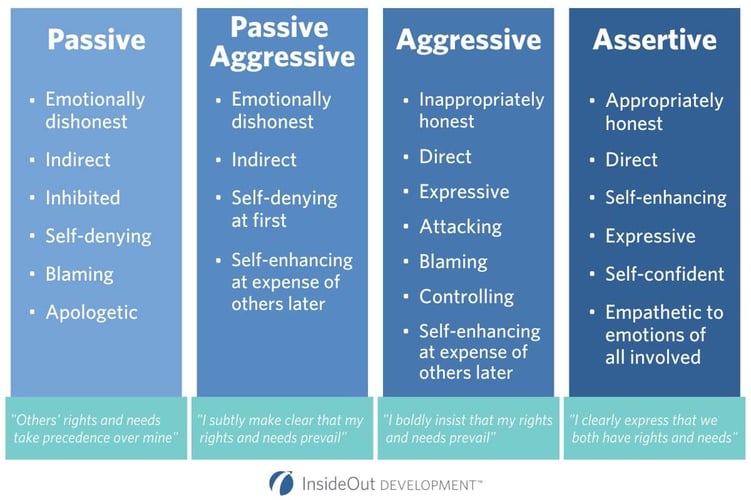As a business leader, your journey is woven with a diverse variety of personalities, both within your organization and beyond.
Recognizing and understanding these individual variations in personality and communication styles is an essential element of effective leadership. Within the realm of communication, we can identify four primary archetypes: assertive, passive, aggressive, and passive-aggressive.
In this article, we will discuss the intricacies of these communication styles, empowering you with the knowledge to develop a deeper understanding of yourself and your employees. By fostering this awareness, you can strengthen your ability to connect and engage with others on a whole new level.
Communication Style 1: Assertive
A self-confident and direct communication type, those with an assertive personality are able to hold their ground and say what they mean without coming off as too “abrasive” to others.
Benefits
- Effective communication: Assertive individuals excel in expressing their thoughts, ideas, and opinions clearly and directly.
- Respect and influence: Assertive individuals command respect from others due to their ability to assert their viewpoints without resorting to aggression.
- Increased self-confidence: The assertive communication type instills a sense of self-assurance. This self-confidence empowers individuals to take on challenges, pursue goals, and assert themselves in various aspects of life.
Challenges
- Perceived as aggressive: Despite their intention to be direct and honest, assertive individuals may be perceived as aggressive or confrontational by those who are more passive or non-confrontational.
- Pushback and resistance: Some individuals may resist or push back against assertive personalities, particularly if they are accustomed to more passive communication styles.
- Potential for conflict: Due to their direct nature, assertive individuals may find themselves engaged in conflicts more frequently. It becomes essential to manage these conflicts effectively, ensuring they do not escalate and harm relationships or work dynamics.
Communication Style 2: Passive
Known to be peacemakers and harmonious individuals, the passive communication style does everything they can to avoid conflict and “keep the peace.”
Benefits
- Harmonious relationships: Passivity often leads to a non-threatening and agreeable demeanor, fostering positive interactions with others.
- Listening and empathy: Passive individuals tend to be good listeners and empathizers. Their passive nature allows them to be attentive to others' needs and concerns, making them approachable and supportive in interpersonal relationships.
- Smooth team dynamics: In collaborative settings, passive individuals may contribute to a more harmonious team dynamic by minimizing friction and promoting cooperation.
Challenges
- Lack of assertiveness: Passivity can lead to individuals not expressing their opinions, desires, or needs clearly.
- Reliance on others' decision-making: The passive communication type may find it challenging to make decisions independently.
- Self-deception and dishonesty: Passivity can sometimes lead to individuals being dishonest with themselves and others.
Communication Style 3: Aggressive
Often seen as honest and expressive, the aggressive archetype is the bulldog of personalities since they are able to express their unfiltered thoughts, freely.
Benefits
- Clear and direct communication: Aggressive individuals are often perceived as honest and expressive because they have no hesitation in expressing their thoughts and opinions.
- Initiative and proactivity: Aggressive individuals are proactive and take the initiative in various situations.
- Resilience: Aggressive individuals are often undeterred by setbacks, enabling them to persevere in the face of challenges.
Challenges
- Perceived as intimidating: Aggressive individuals may be seen as intimidating or domineering by others, which can create barriers to establishing harmonious relationships.
- Lack of empathy and sensitivity: Those with an aggressive communication style may struggle with empathizing and considering the feelings and perspectives of others.
- Damaged relationships: The forceful nature of aggressive personalities can strain relationships over time. Their directness and disregard for potential consequences may lead to broken trust, resentment, and strained connections with others.
Communication Style 4: Passive-Aggressive
The passive-aggressive personality is a mix between the passive and aggressive communication styles. Instead of openly expressing their feelings or thoughts, individuals who exhibit passive-aggressive communication often resort to subtle, ambiguous, or manipulative tactics to convey their discontent.
Benefits
- Maintaining pleasant relationships: By combining passive and aggressive tendencies, individuals with a passive-aggressive personality may navigate social dynamics without causing immediate disruptions.
- Veiled expression of frustrations: The passive-aggressive approach allows individuals to express their frustrations indirectly.
- Gets empathy and support from others: By hinting at their needs or concerns, passive-aggressive individuals may receive support and understanding from those who interpret their indirect cues.
Challenges
- Communication misunderstandings: The indirect and often ambiguous nature of passive-aggressive communication can lead to misunderstandings and misinterpretations.
- Lack of authenticity: The inconsistency between expressed and underlying emotions may cause others to question their authenticity, leading to strained connections.
- Increased resentment: The inability to openly address concerns may contribute to long-term resentment and frustration.
Identifying Your Communication Style
While each of the aforementioned communication styles comes with its own set of advantages and drawbacks, it is crucial for you to embark on a personal journey of self-reflection. Taking an honest look at your own communication patterns is the key to unlocking growth and development, both professionally and in your personal relationships.
So, you may be asking yourself, “What is my communication style?” Here is how you can decode your personality type.
Look Internally
Before doing anything else, we want you to ask yourself a few questions.
Are you consistently honest and transparent when interacting with others? Do you possess the ability to express yourself directly and assertively, or do you tend to shy away from conflict and difficult conversations?
Answering these questions, you will get a baseline speculation for your communication style.
Use Tools
To help further this personality exploration, you should consider leveraging the plethora of tools and quizzes available online.
These resources can provide valuable insights into your tendencies and preferences when it comes to interacting with others.
Ask Others
Seeking feedback from trusted individuals in your life can offer invaluable perspectives on your communication style. Their observations and insights can provide a more well-rounded view of how you come across in various situations.
Remember, true progress begins with transparency within yourself. By cultivating an honest and open attitude, you create a foundation for genuine self-identification.
Adapting and Improving Communication Styles in the Workplace
As a leader within your organization, it is crucial to recognize the significance of adaptability in various situations.
From conducting difficult performance conversations to managing workflow changes, the ability to adjust your communication style is essential for effective leadership.
Here at InsideOut Development, we understand the intricacies of workplace conversations and the importance of minimizing interference to achieve optimal outcomes. That's why we have developed the GROW Coaching model, a comprehensive framework designed to assist business leaders like you in navigating these complex waters.
The GROW Coaching model not only guides you on how to communicate effectively but also illuminates the pitfalls to avoid. Exploring both aspects, we empower you to enhance your communication skills and foster meaningful connections within your team. Connect with our team to learn more!
Self-Awareness Is Beyond Self
To wrap up, self-awareness in communication is important — especially as a business leader.
A significant facet of this self-awareness involves recognizing the diverse communication styles prevalent in both professional and personal realms. From the assertive and passive to the aggressive and passive-aggressive personality types, understanding these styles empowers us to navigate interactions with mastery.
We encourage you to embrace constructive communication styles to cultivate empathy, broaden your perspectives, and ultimately foster stronger connections with others.
It's time to break free from the shackles of fear that often accompany difficult discussions. In this resource, we reveal three powerful strategies that will empower you to navigate tough conversations with grace and tact.





